Compensation (of which sales commission structure is a critical part) plays a highly influential role in driving rep behavior. And it becomes particularly important when reps don’t want to stay around in one company for too long.
It takes an average of 3 months for a new seller to interact with buyers, 9 for them to perform competently, and 15 for them to become top performers. However, the average tenure that reps remain with an organization for is only 1.4 years in 2022.
This shows that once reps have learned all they can with you, they’ll move on to a new organization (most likely one that pays better).
Just hiring the best reps isn’t enough to increase sales. They should be motivated enough to stick around through the ups and down and simultaneously improve their performance.
To achieve this, you need to tailor a sales commission structure template that gives them the incentive to always come out on top.
Let’s find out how.
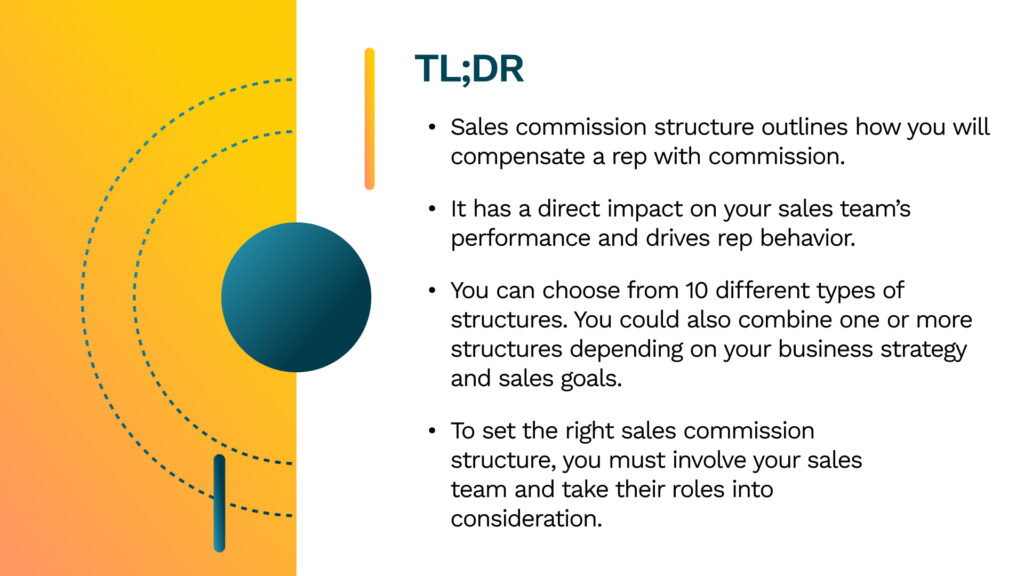
What Is a Sales Commission Structure?
“Sales commission” is the amount sales reps earn on each sale.
“Sales commission structure” outlines how you will compensate the rep with a commission and how much this amount should be, based on the sale.
It also includes the timelines for commission payment, i.e., when you’ll pay reps their commission—weekly, monthly, quarterly, or something else.
Remember, the plan you choose directly impacts your reps’ earnings. Therefore, it’s vital that you set up a fair and sufficiently rewarding sales commission structure template.
How Does a Sales Commission Structure Compare to a Sales Compensation Plan?
Sometimes, commission may be confused with compensation. Here’s a simple tip to differentiate between them.
A compensation plan includes the rep’s total earnings—salary (or fixed pay), commission, incentives, bonus, and on-target earnings (OTE).
As you can see, the commission is just one part of the overall compensation plan. It doesn’t denote compensation in its entirety.
Types of Sales Commission Structure Templates
There are several sales commission structures you can choose from. It could also be that your team or organization needs a unique sales commission structure template. So, sometimes you may need to combine a couple of these plans.
Below are 10 popular structures you can try.
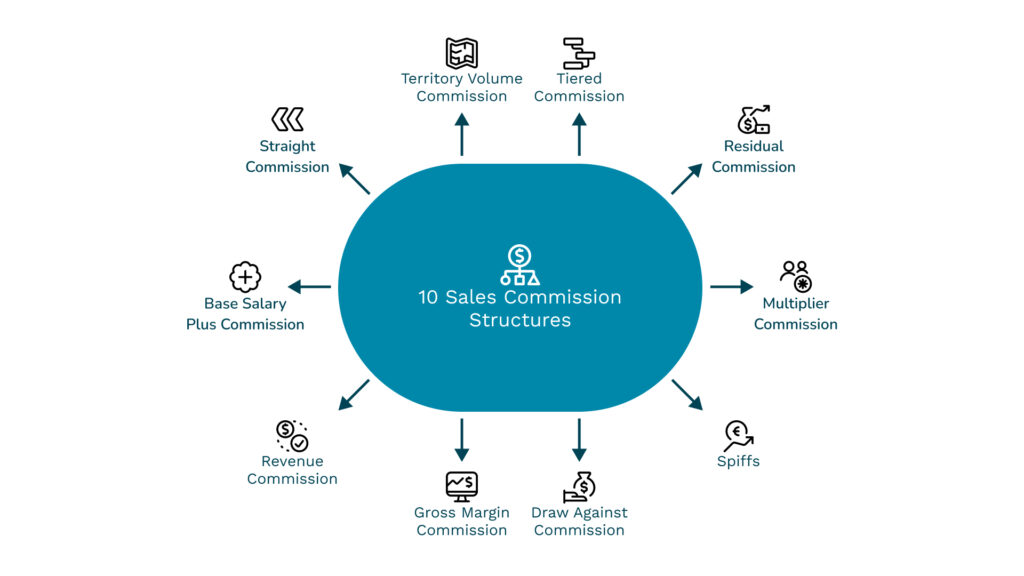
1. Straight Commission
This sales commission structure doesn’t include a base pay or fixed salary. Instead, reps earn 100% commission based entirely on deals they close.
For instance, if a rep closes a deal for $100,000 and the straight commission rate is 10%, the rep will earn $10,000 as commission (without any base pay).
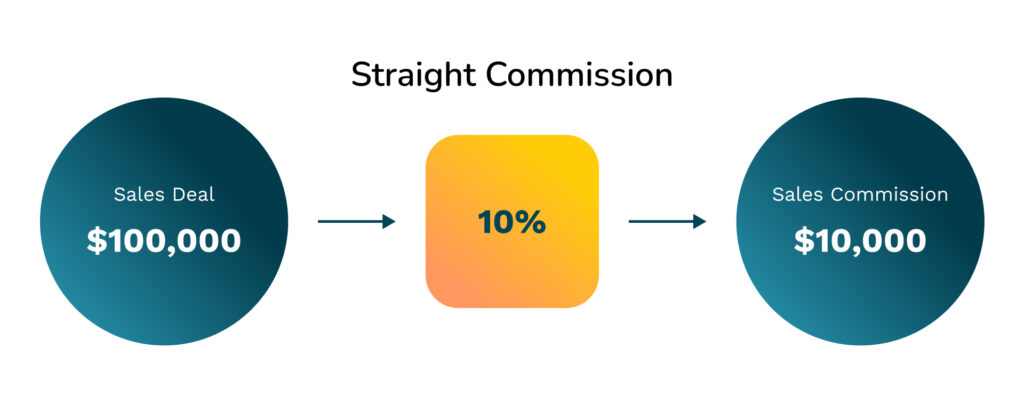
Straight commission is gradually moving out of favor among sales organizations because retaining talent is challenging without the security of fixed pay. It only increases reps’ stress levels and may push them to partake in bad sales practices.
Also, each rep has their own set of skills and practices that make them unique. A straight sales commission structure template doesn’t account for these skills.
When to use this structure:
Shortcomings of the straight commission structure don’t completely nullify its usefulness. You can turn to this plan if you’re a startup or a small organization with limited capital.
2. Base Salary Plus Commission
This structure is the most widely adopted across industries and organizations.
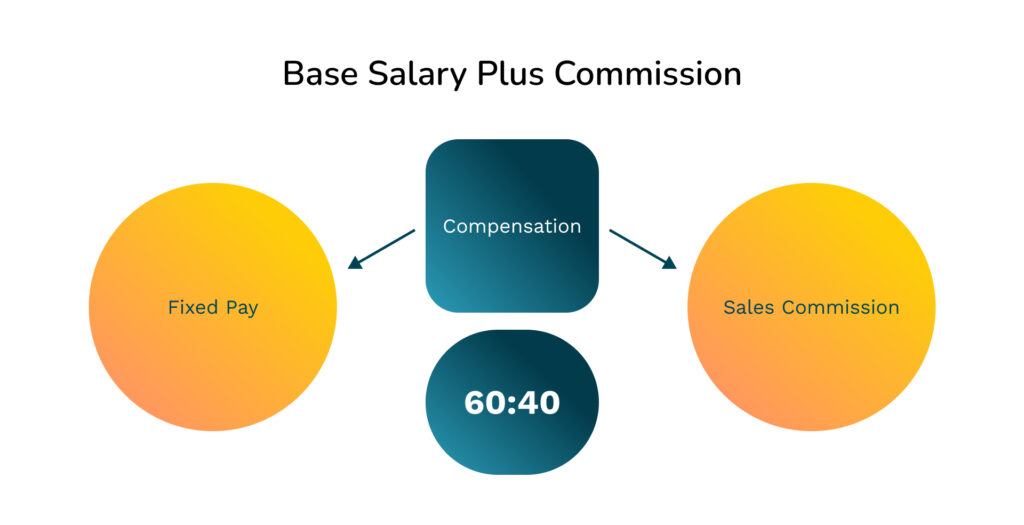
Typically, a rep’s compensation is split between salary and variable pay (which includes commission). The split may be 50/50 or 60/40, depending on what you can offer as a salary while still incentivizing reps.
A “base salary plus commission” structure works well because commission motivates reps to continue improving their performance, whereas salary acts as a safety net to retain them in tough situations.
When to use this structure:
You can deploy this sales commission structure template if you’re striving to maintain a good balance between your sales budget and commission.
3. Revenue Commission
In a “revenue commission” structure, reps earn a flat commission percentage on each deal won. So, if your rep closes a deal for $100,000 and the commission is set at 7%, they earn a commission of $7,000.
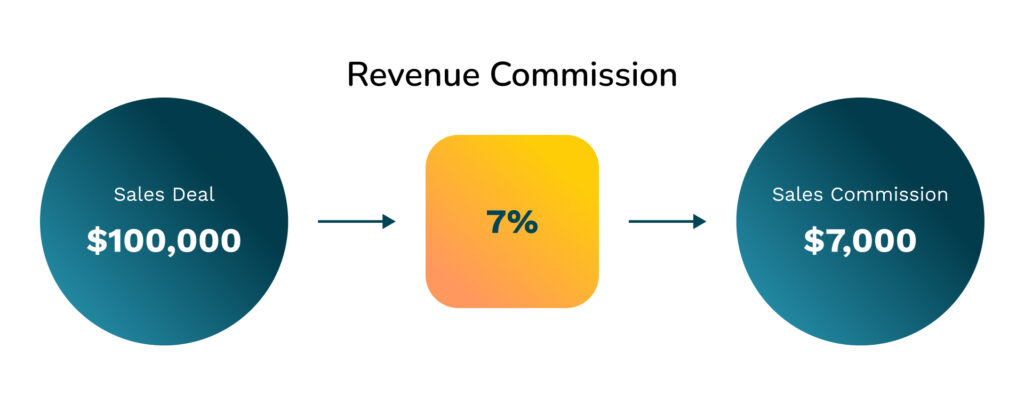
However, this structure again doesn’t consider each rep’s distinctive selling capabilities.
When to use this structure:
Revenue commission works well when your team is small, your product offerings aren’t too complex, or you’re selling only one product with fixed pricing.
4. Gross Margin Commission
The gross margin commission structure follows a similar approach to the revenue commission structure.
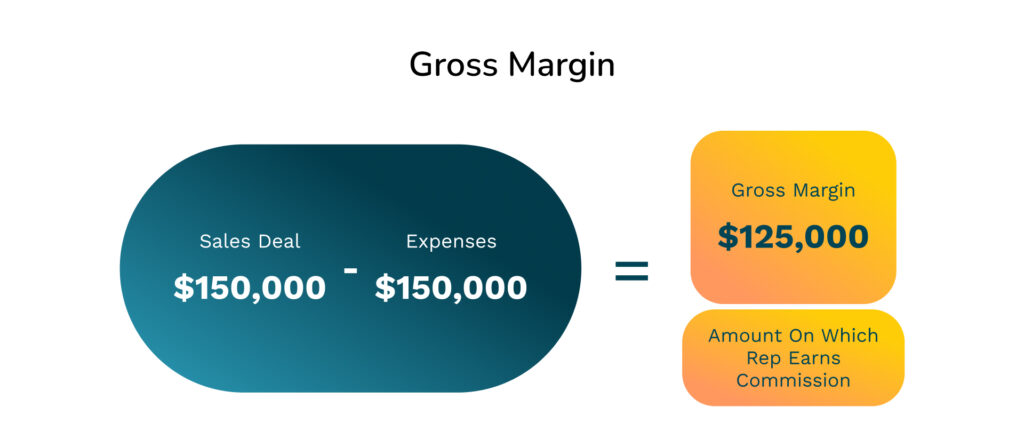
However, instead of revenue (ARR or contract value), reps earn commission on the gross revenue (or profit on sales).
Say your rep sold a contract for $150,000 but incurred a cost of $25,000 for the company. These costs may include travel to meet the client or a discount for the buyer. Under the gross margin commission structure, the rep will earn a commission on $125,000 ($150,000 less $25,000).

Gross margin commission motivates reps to close deals at higher margins, ultimately benefiting the organization.
When to use this structure:
If you aim to ensure bottom line profitability, this sales commission structure template can help reps win deals without incurring too much expense. This may also speed up the sales cycle.
5. Tiered Commission
In tiered commission, reps earn incremental commission on each deal closed, depending on the tier in which it falls.
The bigger the deal closed, the higher the tier and the higher the commission earned.
For example, for deals under $50,000, reps earn a commission of 5%, but for deals under $100,000, the commission moves up to 7%, and so on.
| Tier | Deal Size | Commission |
| A | Up to $50,000 | 5% |
| B | $50,000 to $100,000 | 7% |
| C | $100,000 to $150,000 | 10$ |
Tiered commission encourages reps to continually achieve and exceed targets for higher rewards. But, to maintain your business’s profitability, you may want to cap the maximum commission a rep can take home.
When to use this structure:
A tiered commission structure works best when scaling your team, as it promotes over-performance and separates top performers from low. Not just that, it also motivates average and low performers to push for more.
6. Draw Against Commission
In this sales commission structure template, reps can draw a predetermined commission amount with the salary. The amount is a guarantee, similar to a loan or advance payment.
Depending on your setup, you may or may not ask your reps to return the amount if they don’t hit targets.
When to use this structure:
Use the draw against commission structure to ramp up a new hire or offer stability and incentive for reps to stay during uncertain times.
7. Multiplier Commission
A multiplier sales commission structure lets you create a custom plan.
In this structure, a standard commission rate is multiplied by a predetermined percentage factor of each rep’s quota attainment.
For instance, your standard commission rate is 10%, then your multiplier commission will be:
| Quota Attainment | Multiplying Factor | Commission Earned |
| 50% | 0.5 | 5% |
| 75% | 0.75 | 7.5% |
| 150% | 2 | 12.5% |
Multiplier commission is more complicated than other structures and, therefore, difficult to implement. It may also confuse reps regarding their earnings.
When to use this structure:
The multiplier sales commission structure template is useful to measure reps’ performance against multiple KPIs. It pushes reps to prioritize deals instead of closing just about any deal.
8. Residual Commission
Under the residual commission structure, reps continue to receive a commission from closed deals on an ongoing basis. It goes on as long as the deals continue to generate revenue for the company.
The structure may become a problem when you have a distinction between customer service and sales. That’s because you could end up paying commission twice—once to sales, once to customer success—on upsells and cross-sells.
When to use this structure:
Residual commission works well for businesses that want to build long-term client relationships.
9. Territory Volume Commission
As the name suggests, you pay reps a commission based on defined regions or verticals.
Generally, this type of commission is paid on a team-centric basis rather than individual performance. Commissions are split evenly among the team.
Territory volume commission helps avoid conflict between teams while ensuring you have maximum coverage over each location or vertical.
When to use this structure:
It’s ideal for companies with a presence in multiple locations or those that need multiple sales touchpoints within a team to close a deal.
10. Spiffs
Spiffs are “sales performance incentive funds” offered on a short-term basis to motivate reps. Spiffs act as an extra incentive for achieving specific goals.
For instance, reps could earn additional commission for closing a multi-year deal instead of a single-year one or collecting more cash upfront.
That’s a lot to take in. But why is getting your sales commission structure right so important?
Understanding Sales Commission Structure’s Impact on Rep Performance
Sales commission structure has a direct impact on rep performance and, therefore, an influential impact on your bottom line.
When you get the sales commission structure template right, it:
- Aligns reps’ goals with business goals.
- Sets clear expectations.
- Motivates reps to continue chasing upside potential.
- Boosts productivity.
- Improves job satisfaction and rep commitment.
- Increases retention of high-performing reps.
- Helps measure rep performance and assess improvement areas.
But what happens when it goes wrong?
You end up:
- Risking quantity over quality – affects the customer experience.
- Upholding individual success over team collaboration.
- Induce higher stress levels among reps. Nearly 90% of sellers were burned out in 2022.
- Negatively impact job satisfaction levels.
- Being considered inequitable and unfair.
- Damaging the rep-sales leader partnership.
- Adversely affecting the bottom line by incentivizing underperformers or not maximizing revenue per lead.
This brings us to the next most important question. How do you select the best sales commission structure and the correct type?
Setting the Right Sales Commission Structure for Your Team
Before you start planning a sales commission structure, you must follow a few ground rules. Here are the rules, summed up concisely:
Now that you know the ground rules, let’s move on to a step-by-step approach to creating the right sales commission structure template for your team.
Step 1: Look at Previous Plans
If you’ve set a sales commission structure before or have one in place already, start there. Understand the plan’s performance–what worked and what didn’t. Ask yourself if you’re driving the right sales behavior with your incentives.
To solidify your findings, consider taking inputs from your team by being open with them.
It will also help you determine which sales methods and processes worked best to achieve business goals.
Step 2: Evaluate Goals
The next step is evaluating your business goals, mainly sales goals. Even if you’ve never set a sales commission structure template, this is the best place to start.
Goals ensure you already have benchmarks in place. Determining what you’d like to achieve with your structure is easier when it’s tied back to sales goals.
But remember to be specific with your goals. For instance, just “improving sales revenue” isn’t enough. Outline “how” you will achieve the goal.
Alongside goals, reviewing your sales revenue forecast and budget for the particular period is also important.
Step 3: Consider Different Job Roles
A sales team comprises multiple roles, including SDRs, AEs, supervisors, managers, and inside-outside sales reps. Each role comes with its own set of responsibilities and business vision.
Since each role is unique, your team members must be compensated differently.
Then there’s seniority to consider, too. The longer a rep spends with your organization, the more tailored their role becomes. So, a senior member may take on more important tasks than the others.
For example, a manager has more experience and responsibilities than an AE and may receive a different commission rate.
Other than seniority and responsibilities, you may also need to consider locations (if you’re selling to multiple regions), products, and selling channels.
You must dig deep into how each role sources, influences, and closes deals.
Step 4: Take Note of KPIs
KPIs are useful to analyze individual performance–identifying high and low performers.
You need to look at the numbers for each team member concerning their role. Consider overlaps in territories, products, schedules, and responsibilities to gauge performance correctly.
KPIs and sales metrics also direct your reps to analyze and improve their own performance. If they’re more engaged with their numbers, they are better sellers.
Step 5: Consider Turnover Rates
This is particularly important since turnover in sales is as high as 35%. Moreover, 51% of salespeople can leave your company if they get better pay elsewhere.
Factor in your current turnover rate to check how your current commission structure or compensation plan works. If you see a high turnover rate, your existing plan is ineffective, and there’s room for improvement.
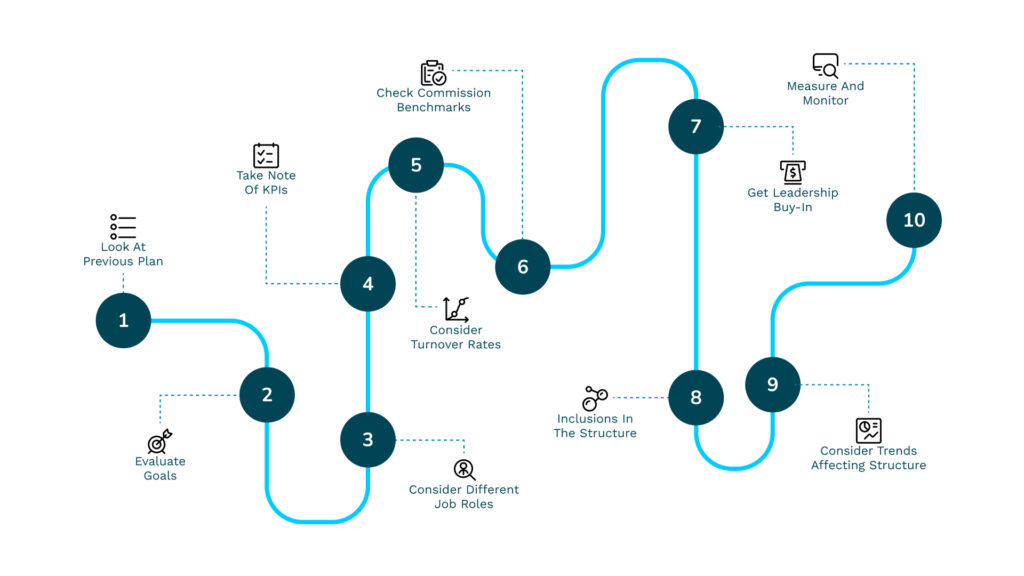
Step 6: Check Commission Benchmarks
To set competitive commission rates and avoid reps leaving, look at benchmarks within your industry. Rates differ for each industry, ranging from 5% of a sale to even 30% of gross margins.
Check how direct competitors compensate their sales teams. And determine how you can match those rates or beat them to reduce turnover.
Commission benchmarks also help you run OTE simulations. OTE is the total amount you’ll pay sales team members once they achieve specific targets.
Step 7: Get Leadership Buy-in
Leadership buy-in is crucial when your sales commission structure could create a financial or cultural shift.
Get your key stakeholders to weigh in on your commission plan, show how the structure adds value to the business, use reliable data and insights, and win their support.
Step 8: Inclusions in the Structure
When drawing up the structure, here’s what your plan must include:
- Type of commission structure.
- Commission rate(s).
- The timelines for commission payment.
- Definitions for important terms (new business, new sale, new account, etc.) on which the rep will earn a commission.
- Mention that the plan is subject to change.
Step 9: Consider Trends Affecting Structure
Technology is constantly bringing in new changes in the sales industry. It’s important to check structures that are out-of-date based on new trends like:
- The inclusion of GenZ in the workforce: Recent research shows they need the highest salary of all generations to feel adequately compensated.
- The sales learning curve: It’s constantly improving with new solutions for evolving pain points.
- The selling process: This is more complex today, resulting in longer sales cycles. At the same time, hiring reps is costlier, and team selling has become more prominent.
Step 10: Measure and Monitor
The ground rules state that your plan must be flexible and adaptable. To do so, you must regularly monitor and revise the sales commission structure as per performance, business strategy changes, forecast changes, and trends.
You should do this every quarter to be on top of any changes.
To measure and monitor, look at your team’s KPIs, targets achieved, productivity, and turnover rate.
Use Sales Activity Tracking to Set the Right Commission Structure
No matter which commission structure you choose, you need the right data in your CRM to make it work. But the reality is that most critical data is buried in sales tools and dashboards, never making its way into the CRM. This, along with dirty data in the CRM like duplicate records or outdated data, further magnifies the problem.
The result? The commission structures you create are faulty, leading to inefficiency and underproductivity.
Solve this by automatically filling your CRM with clean and complete data. Nektar’s AI tool drives funnel efficiency by plugging your CRM data holes and discovering hidden data usually left ignored.
With clean and complete activity data in your CRMs, you have complete visibility into your rep’s activities which is a prerequisite to building a solid sales commission structure.
Having a unified view with clean and accurate data helps you:
- Set a more fair and effective commission structure
- Track sales activity
- Get reliable data and tailored insights
- Align goals and KPIs with the sales team, and
- Adapt to changing conditions.
Improve your commission accuracy with sales activity tracking using Nektar.
Get in touch with our team to find out more!







